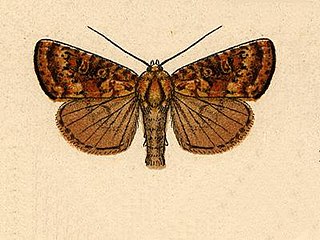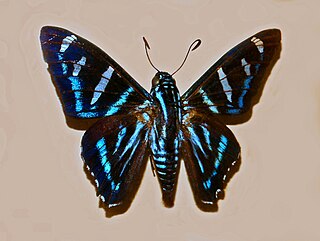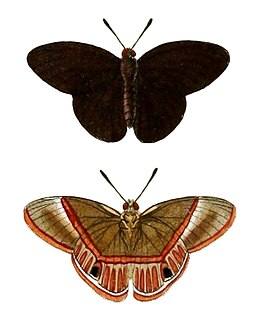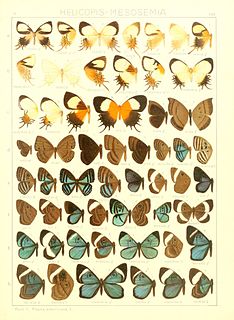Related Research Articles

Camissecla is a genus of butterflies in the family Lycaenidae. The genus was erected by Robert K. Robbins and Marcelo Duarte in 2004. The species of this genus are found in the Neotropical realm.
Paranerita is a genus of moths in the family Erebidae erected by George Hampson in 1901.

Perigea is a genus of moths of the family Noctuidae. The genus was erected by Achille Guenée in 1852.

Thagona is a genus of moths in the subfamily Lymantriinae. The genus was described by Möschler in 1883.

Jemadia is a Neotropical genus of firetips in the family Hesperiidae.

Pyrrhopyge is a Neotropical genus of firetips in the family Hesperiidae.

Pyrrhopygopsis is a Neotropical genus of grass skippers in the family Hesperiidae.

Ephialtias draconis is a moth of the family Notodontidae first described by Herbert Druce in 1885. It is found in Panama, and has been recorded from southeastern Peru and northern Bolivia, with few intervening specimens from Colombia or Ecuador.

Duboisvalia ecuadoria is a moth in the Castniidae family. It is found in Ecuador, Colombia, Peru and Bolivia.
Heliconius numata, the Numata longwing, is a brush-footed butterfly species belonging to the family Nymphalidae, subfamily Heliconiinae.

Pieriballia is a genus of butterflies in the family Pieridae erected by Alexander Barrett Klots in 1933. Its only species, Pieriballia viardi, the painted white or viardi white, was first described by Jean Baptiste Boisduval in 1836. It is found from Mexico to Bolivia and Paraguay. Strays can be found in southern Texas in the United States. The habitat consists of rainforests and transitional cloud forests.
Amaxia theon is a moth of the family Erebidae. It was described by Herbert Druce in 1900. It is found in French Guiana, Venezuela, Ecuador, Peru and Bolivia.
Antichloris ornata is a moth of the family Erebidae. It was described by Herbert Druce in 1883. It is found in Ecuador, Bolivia and Colombia.
Cosmosoma eumelis is a moth of the family Erebidae. It was described by Herbert Druce in 1883. It is found in Ecuador, Bolivia and Brazil.
Cyanopepla buckleyi is a moth of the subfamily Arctiinae. It was described by Herbert Druce in 1883. It is found in Ecuador and Bolivia.
Halysidota atra is a moth of the family Erebidae. It was described by Herbert Druce in 1884. It is found in Guatemala, Mexico, Honduras, Costa Rica, Nicaragua, Panama, Peru, Colombia, Ecuador and Bolivia.

Heliconius aoede, the Aoede longwing, is a species of butterfly of the family Nymphalidae. It was described by Jacob Hübner in 1813. It is found in the Amazon basin. The habitat consists of deep forests.

Euselasia is a genus of butterflies in the family Riodinidae. They are present only in the Neotropical realm. The genus was erected by Jacob Hübner in 1819.

Mesosemia is a genus in the butterfly family Riodinidae present only in the Neotropical realm.

Ancyluris is a butterfly genus in the family Riodinidae. They are resident in the Neotropics.
References
- ↑ Savela, Markku. "Trichromia polyxena (Druce, 1883)". Lepidoptera and Some Other Life Forms. Archived from the original on January 1, 2014. Retrieved September 23, 2019.
| This Phaegopterina-related article is a stub. You can help Wikipedia by expanding it. |